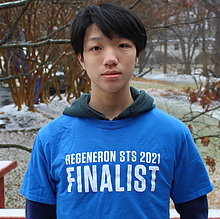 Timothy Qian, a senior at Montgomery Blair High School, has been named a finalist in the Regeneron Science Talent Search (STS) 2021 competition for the research from his Summer 2020 research internship at the University of Maryland.
Timothy Qian, a senior at Montgomery Blair High School, has been named a finalist in the Regeneron Science Talent Search (STS) 2021 competition for the research from his Summer 2020 research internship at the University of Maryland.
Qian performed the work with the mentorship of Alexey Gorshkov, a Fellow in the Joint Center for Quantum Information and Computer Science (QuICS) who is also a Fellow of the Joint Quantum Institute (JQI) and a physicist at the National Institute of Standards and Technology (NIST). Jacob Bringewatt, a graduate student in physics at UMD, also provided mentorship.
“Researching at JQI and QuICS was a new and interesting experience,” Qian says. “My mentors showed me how the research process worked and helped me immensely throughout my project. Being named a finalist is a huge honor, as well as a recognition of the research my mentors and I conducted.”
The Regeneron STS competition is designed to acknowledge original research by high school students in a topic related to science, technology, engineering or math. As a finalist, Qian is one of the top 40 students out of 1,760 entrants and will receive at least $25,000.
“Timothy was super impressive and fun to work with,” Bringewatt says. “He worked really hard and showed a lot of creative independence–in fact he arrived at the essential mathematical insight that broke open the problem for us by making clever use of a beautiful duality theorem he found in the mathematics literature.”
In Qian’s project, titled “Optimal Measurement of Field Properties with Quantum Sensor Networks,” he developed, with the aid of Gorshkov’s lab, a procedure for using networks of quantum sensors to perform optimal measurements of field properties—things like the electric field generated at a particular point by a distribution of electrons or the magnetic field produced by atomic nuclei. The procedure can be used to get the best accuracy that is possible in a limited amount of time or to take the shortest amount of time possible to get a needed level of accuracy. This optimized procedure should help people design quantum technologies that can efficiently work together to gather information about the surrounding world.
“As quantum computers and quantum networks are developed, the global internet of computers and things will inevitably include quantum computers and other quantum devices, such as quantum sensors and quantum clocks,” Bringewatt says. “The protocol that Tim discovered will be a crucial ingredient for allowing us to fully take advantage of this inevitability.”
Gorshkov has mentored other high school students who expressed interest in his lab’s work, including Qian’s older brother, Kevin. Kevin Qian was also acknowledged for his work in Gorshkov’s lab; he was selected as a 2019 Regeneron STS Finalist and placed second in the physics and astronomy category at the International Science and Engineering Fair 2019.
Timothy Qian and this year’s other finalists will have the opportunity to present their work to the public and to compete for the top 10 awards—including a $250,000 prize for the overall winner—in a virtual competition scheduled for March.
—Story by Bailey Bedford
QuICS is a partnership between the University of Maryland and NIST. The center receives technical and administrative support from the University of Maryland Institute for Advanced Computer Studies.